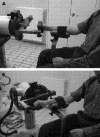An isokinetic eccentric programme for the management of chronic lateral epicondylar tendinopathy
- PMID: 17224433
- PMCID: PMC2658962
- DOI: 10.1136/bjsm.2006.033324
An isokinetic eccentric programme for the management of chronic lateral epicondylar tendinopathy
Abstract
Background: Lateral epicondylitis represents a frequent overuse injury. In spite of many conservative treatment procedures, prolonged symptoms and relapse are frequently observed.
Objective: To compare the outcome of patients performing an isokinetic eccentric training with that of age-, gender-, activity-matched patients receiving a non-strengthening classical rehabilitation.
Methods: Ninety-two patients with unilateral chronic lateral epicondylar tendinopathy (mean duration of symptoms 8+/-3 months) were assigned either to a control group (n = 46) or to an eccentrically trained group (n = 46). The control group underwent a passive standardised rehabilitation programme that excluded strengthening exercises. In addition to this programme, the trained group also performed eccentric exercises based on the repetitive lengthening of the active musculo-tendinous unit. The latter exercises started with submaximal contraction intensity and slow speed movement. Modalities were progressively intensified (increase in intensity contraction and speed movement) over a long period of treatment. Programme effectiveness was assessed through pain score evaluation, a disability questionnaire, muscle strength measurement and ultrasonographic examination.
Results: Compared to the non-strengthening control group, the following observations were made in the eccentrically trained group: (1) a significantly more marked reduction of pain intensity, mainly after one month of treatment; (2) an absence of strength deficit on the involved side through bilateral comparison for the forearm supinator and wrist extensor muscles; (3) an improvement of the tendon image as demonstrated by decreasing thickness and a recovered homogenous tendon structure; and (4) a more marked improvement in disability status during occupational, spare time and sports activities.
Conclusion: These results highlight the relevance of implementing isokinetic adapted eccentric training in the management of chronic lateral epicondylar tendinopathy.
Similar articles
-
Chronic lateral epicondylitis: comparative effectiveness of a home exercise program including stretching alone versus stretching supplemented with eccentric or concentric strengthening.J Hand Ther. 2005 Oct-Dec;18(4):411-9, quiz 420. doi: 10.1197/j.jht.2005.07.007. J Hand Ther. 2005. PMID: 16271688 Clinical Trial.
-
An exercise programme for the management of lateral elbow tendinopathy.Br J Sports Med. 2005 Dec;39(12):944-7. doi: 10.1136/bjsm.2005.019836. Br J Sports Med. 2005. PMID: 16306504 Free PMC article. Review.
-
Addition of isolated wrist extensor eccentric exercise to standard treatment for chronic lateral epicondylosis: a prospective randomized trial.J Shoulder Elbow Surg. 2010 Sep;19(6):917-22. doi: 10.1016/j.jse.2010.04.041. Epub 2010 Jun 26. J Shoulder Elbow Surg. 2010. PMID: 20579907 Clinical Trial.
-
Comparison of effects of eccentric training, eccentric-concentric training, and eccentric-concentric training combined with isometric contraction in the treatment of lateral elbow tendinopathy.J Hand Ther. 2017 Jan-Mar;30(1):13-19. doi: 10.1016/j.jht.2016.09.001. Epub 2016 Nov 4. J Hand Ther. 2017. PMID: 27823901 Clinical Trial.
-
Five-year prospective comparison study of topical glyceryl trinitrate treatment of chronic lateral epicondylosis at the elbow.Br J Sports Med. 2011 Apr;45(5):416-20. doi: 10.1136/bjsm.2009.061002. Epub 2009 Jun 23. Br J Sports Med. 2011. PMID: 19553221 Review.
Cited by
-
Maximum Strength Benchmarks for Difficult Static Elements on Rings in Male Elite Gymnastics.Sports (Basel). 2021 May 28;9(6):78. doi: 10.3390/sports9060078. Sports (Basel). 2021. PMID: 34071632 Free PMC article.
-
Treating lateral epicondylitis with corticosteroid injections or non-electrotherapeutical physiotherapy: a systematic review.BMJ Open. 2013 Oct 29;3(10):e003564. doi: 10.1136/bmjopen-2013-003564. BMJ Open. 2013. PMID: 24171937 Free PMC article.
-
Eccentric strengthening for chronic lateral epicondylosis: a prospective randomized study.Sports Health. 2011 Nov;3(6):500-3. doi: 10.1177/1941738111409690. Sports Health. 2011. PMID: 23016049 Free PMC article.
-
Chronic pain alters spatiotemporal activation patterns of forearm muscle synergies during the development of grip force.J Neurophysiol. 2017 Oct 1;118(4):2132-2141. doi: 10.1152/jn.00210.2017. Epub 2017 Jul 19. J Neurophysiol. 2017. PMID: 28724779 Free PMC article.
-
Manual therapy and exercise for lateral elbow pain.Cochrane Database Syst Rev. 2024 May 28;5(5):CD013042. doi: 10.1002/14651858.CD013042.pub2. Cochrane Database Syst Rev. 2024. PMID: 38802121 Free PMC article. Review.
References
-
- Hong Q N, Durand M J, Loisel P. Treatment of lateral epicondylitis: Where is the evidence? Joint, Bone, Spine: Rev Rhum 200471369–373. - PubMed
-
- Ciccotti M G, Charlton W P. Epicondylitis in the athlete. Clin Sports Med 20012077–93. - PubMed
-
- Järvinen M. Epidemiology of tendon injuries in sports. Clin Sports Med 199211493–504. - PubMed
-
- Pienimäki T T, Kauranen K, Vanharanta H. Bilaterally decreased motor performance of arms in patients with chronic tennis elbow. Arch Phys Med Rehabil 1997781092–1095. - PubMed
MeSH terms
LinkOut - more resources
Full Text Sources
Medical


